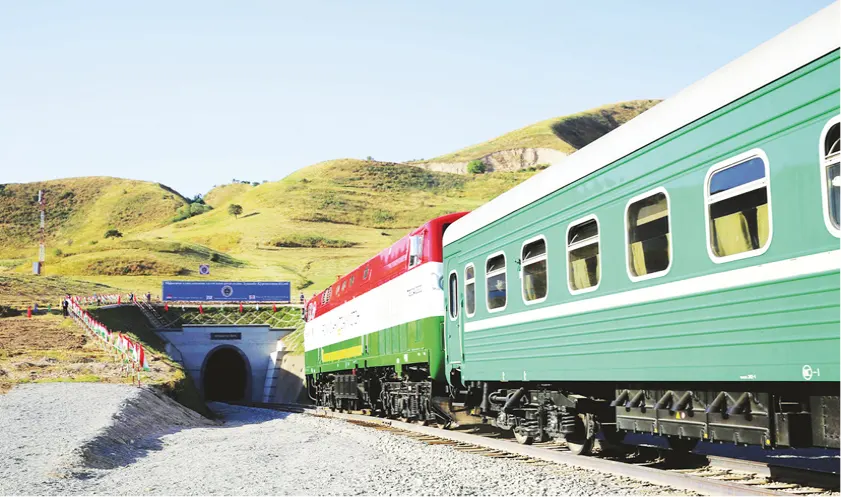The past year 2023 was a busy one for China in terms of its interactions with the rest of the world. Its foreign relations always have a profound impact on its economy, strategy and people’s livelihoods. The Global Times, in collaboration with China’s universities and think tanks, is now releasing a series of country reports. The aim of these reports is to enhance understanding of relevant countries, provide a framework for dealing with China’s relations with these countries, and grasp the trajectory of these relations.
In the fourth report of the series, we focus on Tajikistan, a country located in Central Asia.
Over the past decade, China and Tajikistan have collaborated to build the China-proposed Belt and Road Initiative (BRI), achieving significant progress in infrastructure, agriculture, culture and trade through extensive cooperation. The two countries should further promote the bilateral high-quality construction of the BRI by taking the following actions: first, fully implementing the consensus reached at the China-Central Asia Summit; second, prioritizing the United Nations 2030 Agenda for Sustainable Development, promoting relevant projects in Tajikistan with infrastructure projects as the core, attaching importance to small-scale projects, such as dispatching Chinese medical teams to Tajikistan at the grass-roots level and promoting agricultural technology in villages; third, publicizing the mutually beneficial cooperation between China and Tajikistan.
Fruitful results of BRI cooperation
Tajikistan has been one of the countries that have responded most positively to the BRI since it was put forward. In September 2014, China and Tajikistan signed a Memorandum of Understanding on building the Silk Road Economic Belt during Chinese President Xi Jinping’s state visit to Tajikistan. In 2016, Tajikistan enacted the National Development Strategy of the Republic of Tajikistan for the period up to 2030, which is in deep connection with the BRI. In 2017, President of Tajikistan EmomaliRahmon was in China for a state visit, during which he attended the Dialogue between Emerging Market Economies and Developing Countries, and the two countries signed a joint announcement on establishing a comprehensive strategic partnership. In May 2023, Rahmon came to China for the China-Central Asia Summit.
Thanks to the leadership of the heads of state of China and Tajikistan, bilateral cooperation in the economic and trade fields has developed rapidly. The BRI has brought new vitality to Tajikistan, and the two countries have achieved fruitful results in investment, trade and production capacity cooperation.
In terms of investment, China is Tajikistan’s largest source of foreign investment. The Export-Import Bank of China and other institutions have provided financing for many important infrastructure projects in Tajikistan, including thermal power plants, power grids and transportation. This support has effectively helped Tajikistan in initiating key infrastructure projects and injected a strong impetus into the economic and social development.
In 2017, in the field of aiding construction, China pledged a 1.5 billion yuan grant (over US$230 million) to build new parliamentary buildings for the Tajik government in Dushanbe.
Under the impetus of the BRI, a number of landmark large-scale projects have been successfully implemented in Tajikistan. In transportation construction, the Vahdat-Yavan railway tunnel has become the hub of international railroad transportation connecting China, Tajikistan, Afghanistan and Iran, and the successful completion of the Dushanbe-Chanak Highway has improved Tajikistan’s transport system.
In power construction, the operation of Dushanbe No.2 thermal power plant in Dushanbe marked the city’s power shortage in winter becoming a thing of the past. The South-North power transmission line (500 kV) constructed by TBEA connected Tajikistan’s two major power grids in the north and south of the country, thus alleviating the dependence of the northern regions of Tajikistan on the power supply of Uzbekistan and Kyrgyzstan.
In production capacity cooperation, Tajikistan has turned from a cement importer to an exporter with the support of China. The Tajik-Chinese joint venture, Zeravshan Gold Company (ZGC), has become one of the largest gold mining enterprises in Tajikistan.
China and Tajikistan have also been cooperating in the cultural field. In 2015, the China University of Petroleum (CUP) built the first Confucius Institute with the Metallurgy and Mines Institute of Tajikistan in 2015.










